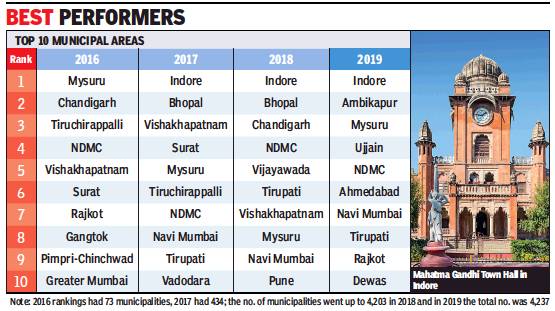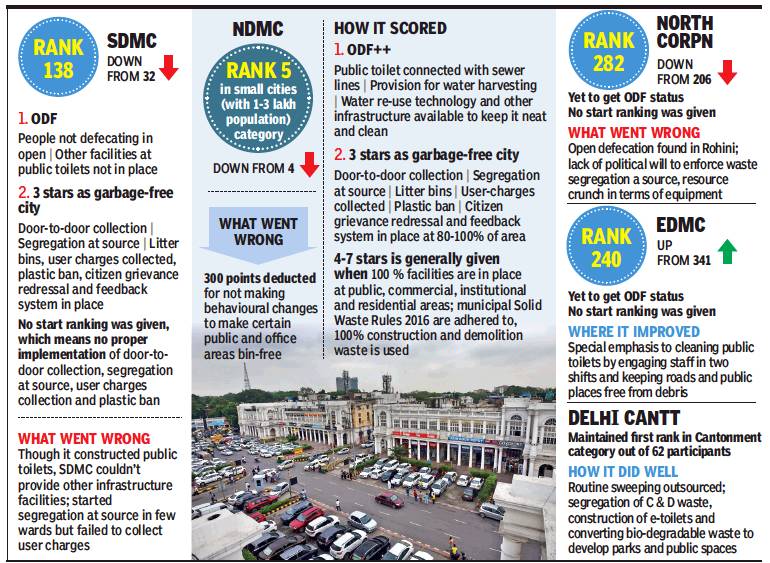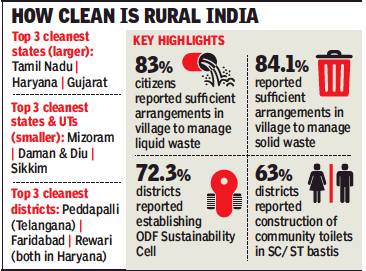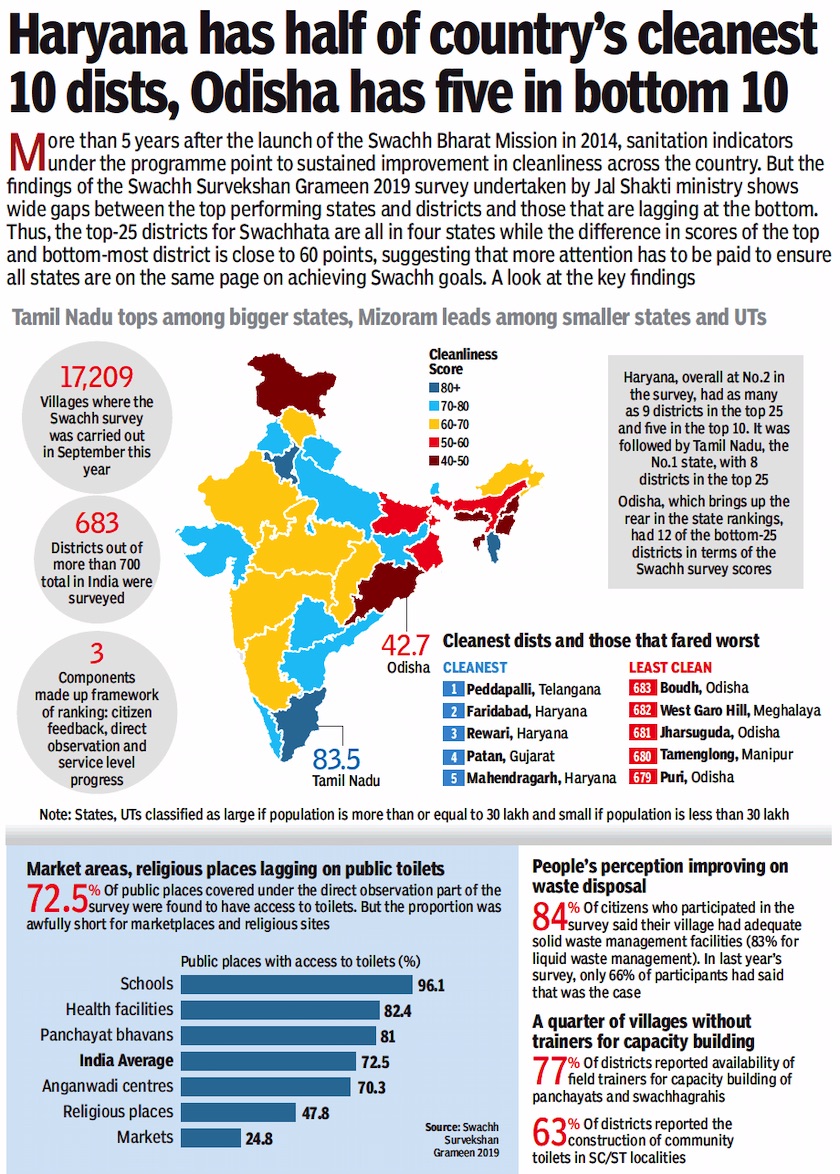Cleanliness ranks of Indian cities, districts: 2019
This is a collection of articles archived for the excellence of their content. |
Contents |
The best and the worst

From: Dipak Dash, Indore does it again, takes top swachh rank for 3rd time, March 7, 2019: The Times of India
Delhi’s NDMC Area Gets Fifth Position
Bhopal bags the cleanest capital award while Indore, Ujjain and Dewas from Madhya Pradesh besides Ahmedabad and Rajkot from Gujarat make it to the list of top 10 Swachh urban areas under more than one lakh population category, according to the latest nationwide survey.
The posh NDMC area, which houses VIPs, ranked fifth on cleanliness parameters. Bhopal municipal area has though slipped to 19 in ranking from the second position it occupied last year.
In the category of urban areas having less than one lakh population, eight municipal areas in Maharashtra have made it to the list of top 10 with Karhad leading the group followed by Lonavala, Mul and Vita. According to the Swachh Survekshan results, the other two municipal areas are Shahaganj in Madhya Pradesh and Dungarpur in Rajasthan. President Ram Nath Kovind handed over the awards to winners.
The cleanliness rankings show that Dewas in MP has made the maximum progress among the municipal areas with over one lakh population. It has become the 10th cleanest municipal area in 2019 as compared to its last year’s rank of 68. Rajkot has also made huge progress to become the ninth cleanest urban area as compared to its earlier rank of 35 in 2018.
The other big jump has been made by Ambikapur, which finished as the second cleanest municipal area this year as compared to its 11th rank in 2018. The four cities that have fallen out of the top 10 group are Chandigarh (20), Pune (37) and Vijayawada (12) besides Bhopal.
Uttarakhand’s Gauchar has been adjudged as the the “Best Ganga Town” in the survey conducted by the housing and urban affairs ministry. The survey carried out in January included direct observation by third party auditors, people’s feedback and service level progress.
The NCR
Gzb up 23 places to 13th in Swachh rankings, NDMC drops 1 to 5th, March 7, 2019: The Times of India

From: March 7, 2019: The Times of India

From: March 7, 2019: The Times of India
See graphics:
Delhi-NCR’s Performance in Swachh Bharat Rankings/ 2018- Part-I
Delhi-NCR’s Performance in Swachh Bharat Rankings/ 2018- Part-II
Ghaziabad has become the best-performing district in Delhi-NCR for the second successive year in the Swachh Bharat rankings. It rose 23 places in the all-India ranking for 2019 released on Wednesday to rise to 13th, and sit eight spots behind New Delhi Municipal Council (NDMC) on the leaderboard. NDMC, which is Delhi-NCR’s top-ranked municipality, slipped a spot from 4th last year to fifth.
Other NCR municipalities were far behind these two —Gurgaon at a distant 83rd was the closest — underlining how the region’s overall delivery of civic services hasn’t quite kept pace with its growth as an economic powerhouse. Ghaziabad was the standout performer because it didn’t even make the first 300 two years ago (ranked 351st in 2017). That jolted the local administration into action — it got its act together, cleaned up roads, removed garbage vats, plugged gaps in waste collection and began beautifying public spaces. The result was a leap to 36th spot in the 2018 ranking, and recognition as India’s most improved district. In Delhi, where three of the five municipalities dropped to lower spots, officials blame factors like a complicated documentation process.
East Delhi improves

From: Vibha Sharma & Paras Singh, East surprises with big jump, NDMC with drop, March 7, 2019: The Times of India
SDMC Biggest Loser In Cleanliness Rank As It Slips 106 Slots
The capital’s municipal bodies have failed to maintain their rankings in the nationwide cleanliness survey carried out by the Union housing and urban affairs ministry in 2019.
The Swachh Survekshan 2019 report released on Wednesday mentions that three of the five municipalities in Delhi fared much worse than their earlier ranks. New Delhi Municipal Council (NDMC), which was at the fifth rank, dropped one position, while South Delhi Municipal Corporation (SDMC) plummeted to the 138th rank from last year’s 32nd.
However, east corporation (EDMC), which was at a historic low of 341 last year, has climbed up 101 spots. North corporation has been adjudged the worst faring area in the capital with 282nd rank. Last year, it was at 206th position. In the separate category of cantonment board rankings, Delhi Cantonment was judged the cleanest among 62 such areas across the country. It held the top spot last year too.
Official attribute the lower rank to change in methodology, complicated procedure of documentation, funds shortage, lack of political will behind enforcing waste segregation at source, implementing user charges and other sanitation facilities. Out of 5,000 marks, NDMC scored 4,191, SDMC 2,642, EDMC 2,095 and north corporation 1,901.
“Before starting the survey, we were told that cities with over one lakh population will be divided into three categories—between 1-3 lakh population, 3-10 lakh and above 10 lakh. However, the old procedure was followed. Cities with three lakh and above population can’t be judged on the same criteria. Those with a population less than three lakh can make the best out of their resources in comparison to those with 50-60 lakh population,” said an SDMC official.
“Moreover, we couldn’t apply for ODF++ ratings because no arrangements could be made for providing additional facilities at public toilets due to shortage of funds and unfavourable conditions to fulfill all norms required for Swachh rankings,” the official said.
NDMC chairman Naresh Kumar said they may have slipped by a position, but the civic body was awarded ODF++ status and 3-star garbage-free city ranking.
A EDMC official said, “We may not have been able to provide world-class facilities, but special emphasis was given on cleaning public toilets by engaging staff in two shifts. We also paid attention to keeping roads and public places free from debris and garbage.”
Congratulating Paryavaran Sahayaks (sanitation workers), East Delhi mayor Bipin Bihari Singh said, “Even in adverse financial conditions, the corporation made serious efforts to keep east Delhi clean and green. We expect a better rank in the next survey.”
North corporation officials attribute their low rank to institutional challenges and geography. “We have still not been able to achieve ODF status, which leads to a large deduction in points. Open defecation was found in Rohini, which has rural areas and a large number of dairy colonies. Also, we are facing a resource crunch and financial constraints,” said an official. The civic body has also failed to implement waste segregation even in its model colonies.
Chitra Mukherjee, a waste management expert from Chintan environment and research action group, said that informal sector in waste management has been ignored. “Municipalities in Delhi claim a lot of things, but they remain on paper. Cities like Mysuru and Goa have already displayed that garbage segregation at source can be done, but we are reluctant to move down the path. Decentralised system is the way forward,” she added.
Ghaziabad’s improvement
A plant to clear construction debris, another to convert vegetable waste to compost and door-to-door collection of garbage — these are some of the factors that have helped Ghaziabad transform itself from a civic laggard to one of the best performers in the nationwide Swachh Bharat rankings for two years in a row, shooting up from 35st in 2017 to 13th this year. While this is not to say that everything is working perfectly in the city, Ghaziabad has taken several key measures for others to emulate.
Construction debris
A plant in Hindon Vihar that became functional in December last year recycles 400 tonnes of debris from construction daily. According to Prateek Joshi, who operates the plant leased out by the GMC, “The city produces 3,000 tonnes of waste in a month and a large quantity is ferried to this plant for recycling.”
“The loose soil is segregated and sold to private parties which use it for levelling the ground while large stones are recycled into mortar chips and used for construction purposes. A part of it is also used for making tiles which are in great demand,” added Joshi. GMC official AK Mishra points out that the waste, which would otherwise be scattered all over the city, has been utilised judiciously because of this plant.
Waste from religious places
To check the waste from religious places that was earlier being dumped into the Hindon river, the GMC in October last year launched a compost plant in the Sai Upvan shrine. “We conducted a survey and identified 91 religious sites, including temples, gurdwaras, mosques and churches and it was found that 1.5 tonnes of such waste is generated daily so we decided to start a separate compost plant which dealt with this only,” he said.
The GMC introduced dedicated vehicles for ferrying the waste and issued toll-free helplines. “We receive nearly 15 calls a day for picking up this waste,” said Mishra.
Door-to-door collection
The GMC successfully implemented door-to-door collection of garbage across all its 100 wards. “A dumping van visits each locality in the wee hours and plays the Swachh Bharat song exhorting residents to dump segregated waste into it. This played a crucial role in the success of the campaign,” explained Mishra.
Using parks for composting
The GMC dug pits in sections of several parks and handed them over to private entities to convert horticulture waste into compost. “This way, we did not allow horticulture waste generated in these parks and green areas to be left out in the open. It was used in these parks for making compost,” said Mishra.
No open vats
A significant change was the disappearance of more than 250 permanent waste-dumping sites in the city. “Tonnes of waste would lie in these spots for days together. While some were covered, waste from others was ferried to designated places on a daily basis,” explained Mishra.
Ragpickers in the system
The GMC mobilised ragpickers, who played a crucial role in the segregation of civic waste across the city. The civic body got Aadhaar cards made for 742 of them. “Their services were used in an organised manner. The ragpickers would hop in on our 336 GPS-enabled vehicles and provide a helping hand in waste collection and segregation at our 15 collection centres. Items which were saleable would be given to them through which they earned money with respect and dignity,” added Mishra.
Champa Devi, a ragpicker in the Sanjay Nagar area, said, “Earlier, I used to drag a magnet-attached stick along the road at five in the morning so that iron particles like nails would stick to it. I would then sell them to factory owners for a measly sum.” In August last year, Devi was introduced to the GMC’s experiment. “It promised to provide me with regular money and dignity which comes with working with GMC,” she said.
Veggie waste to compost
Hundreds of metric tonnes of fruits and vegetable waste found its way into the bylanes of Navyug mandi, rotting and emanating unbearable stench, with cattle feeding on it. “We provided land and equipment for developing a waste-to-compost plant and residents were sensitised to collect vegetable waste and ferry it to the plant,” said Mishra. “We are getting compost which the residents are selling off,” he added, pointing out that this was a “one-of-its-kind” experiment wherein waste was actually providing employment to people. “Six people from Navyug mandi are earning between Rs 15,000 and Rs 20,000 each per month by selling compost,” he said.
Beautification drive
The GMC also took up the task of beautifying the area, covering up eyesores. “A patch of land at Meerut trisection was used to dump waste but it was converted into a park,” Mishra said.
Rural areas
Dipak Dash, Oct 3, 2019: The Times of India

From: Dipak Dash, Oct 3, 2019: The Times of India
Peddapalli in Telangana has jumped two places in the annual sanitation survey to become the cleanest district replacing Satara in Maharashtra. However, the most remarkable improvement was recorded by Faridabad which jumped to the second rank in the this year’s rural swachhta survey findings from a lowly 71 a year back. Rewari, again from Haryana, was placed third in the survey which covered 690 districts in the country.
The drinking water and sanitation department on Wednesday shared only the highlights of survey findings and sources said the detailed report of all districts will be out soon. Among larger states, Tamil Nadu has topped the list from 11th position in 2018. Haryana and Gujarat slipped to second and third positions respectively, each a rank lower than their 2018 performance.
This time the Swachhta Survey was carried out in 17,200 villages in these 690 districts and the ranks were allocated based on quantitative and qualitative sanitation (swachhta) parameters, which included feedback from the people, direct observation by third party assessors and service level progress by the local administration.
2019: Swachh Survekshan Grameen

From: Nov 21, 2019: The Times of India
See graphic:
Results of the Swachh Survekshan Grameen, 2019
See also
Cleanliness ranks of Indian cities, districts: 2014-15
Cleanliness ranks of Indian cities, districts: 2016
Cleanliness ranks of Indian cities, districts: 2017
Cleanliness ranks of Indian cities, districts: 2018
Cleanliness ranks of Indian cities, districts: 2019
Cleanliness ranks of Indian cities, districts: 2020
Cleanliness ranks of Indian cities, districts: 2021